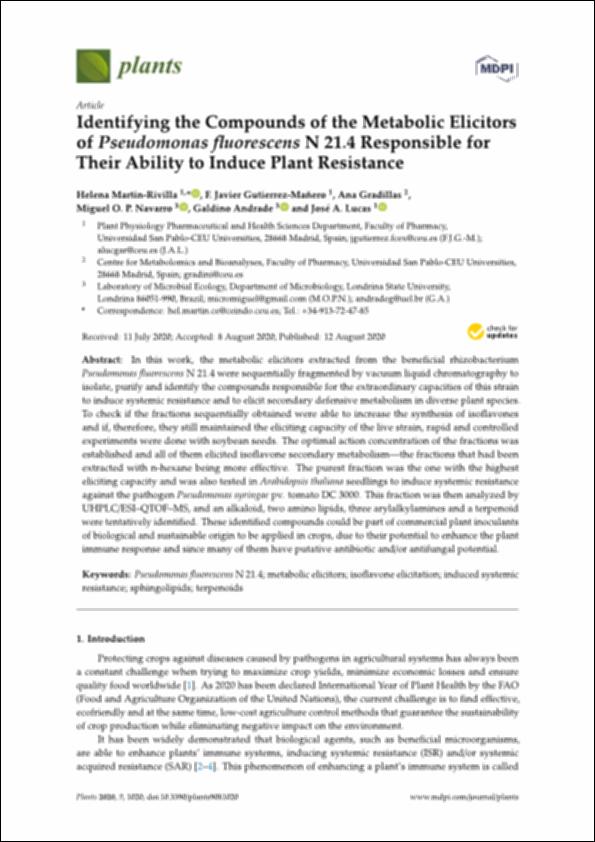Please use this identifier to cite or link to this item:
http://hdl.handle.net/10637/15907Identifying the Compounds of the Metabolic Elicitors of Pseudomonas fluorescens N 21.4 Responsible for Their Ability to Induce Plant Resistance
| Title: | Identifying the Compounds of the Metabolic Elicitors of Pseudomonas fluorescens N 21.4 Responsible for Their Ability to Induce Plant Resistance |
| Authors : | Martín Rivilla, Helena Gutiérrez Mañero, Francisco Javier Gradillas Nicolás, Ana Navarro, Miguel |
| Keywords: | Pseudomonas fluorescens; Metabolic elicitors |
| Publisher: | MDPI |
| Citation: | Martin-Rivilla, Helena, F. Javier Gutierrez-Mañero, Ana Gradillas, Miguel O. P. Navarro, Galdino Andrade, and José A. Lucas. 2020. "Identifying the Compounds of the Metabolic Elicitors of Pseudomonas fluorescens N 21.4 Responsible for Their Ability to Induce Plant Resistance" Plants 9, no. 8: 1020. https://doi.org/10.3390/plants9081020 |
| Abstract: | In this work, the metabolic elicitors extracted from the beneficial rhizobacterium Pseudomonas fluorescens N 21.4 were sequentially fragmented by vacuum liquid chromatography to isolate, purify and identify the compounds responsible for the extraordinary capacities of this strain to induce systemic resistance and to elicit secondary defensive metabolism in diverse plant species. To check if the fractions sequentially obtained were able to increase the synthesis of isoflavones and if, therefore, they still maintained the eliciting capacity of the live strain, rapid and controlled experiments were done with soybean seeds. The optimal action concentration of the fractions was established and all of them elicited isoflavone secondary metabolism—the fractions that had been extracted with n-hexane being more effective. The purest fraction was the one with the highest eliciting capacity and was also tested in Arabidopsis thaliana seedlings to induce systemic resistance against the pathogen Pseudomonas syringae pv. tomato DC 3000. This fraction was then analyzed by UHPLC/ESI–QTOF–MS, and an alkaloid, two amino lipids, three arylalkylamines and a terpenoid were tentatively identified. These identified compounds could be part of commercial plant inoculants of biological and sustainable origin to be applied in crops, due to their potential to enhance the plant immune response and since many of them have putative antibiotic and/or antifungal potential. |
| URI: | http://hdl.handle.net/10637/15907 |
| Rights : | http://creativecommons.org/licenses/by-nc-nd/4.0/deed.es Open Access |
| ISSN: | 2223-7747 |
| Issue Date: | 12-Aug-2020 |
| Center : | Universidad San Pablo-CEU |
| Appears in Collections: | Facultad de Farmacia |
Items in DSpace are protected by copyright, with all rights reserved, unless otherwise indicated.


